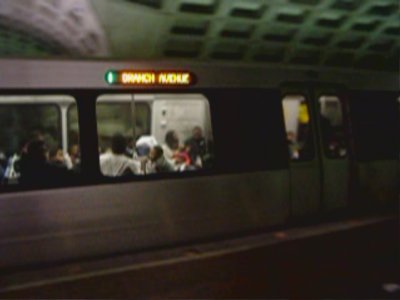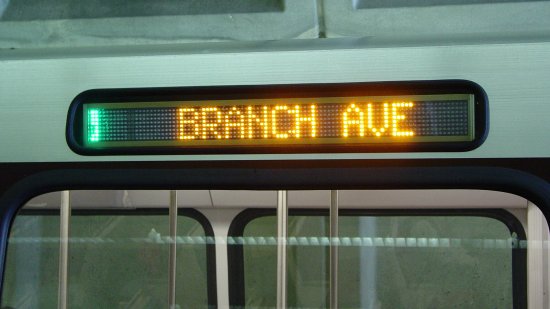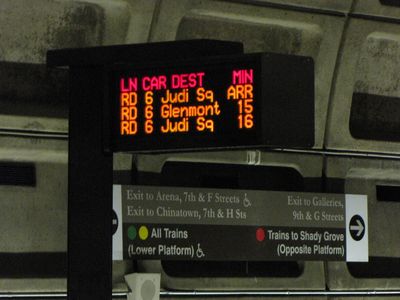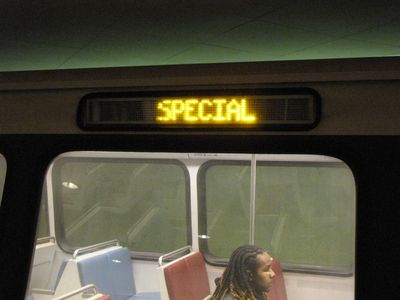What “SPECIAL” really means…
8 minute read
October 3, 2012, 12:14 AM
This morning as I was taking the Red Line to work and reading the Express, I read the DC Rider section, as I usually do. Today, they ran a rider Q&A with Dr. Gridlock. One of the questions that was posed was about Metro’s destination signage, which I quote here along with Dr. Gridlock’s answer:
Q: Why doesn’t Metro label trains during their weekend shutdowns? Several times this weekend on the Green Line, I saw passengers confused by trains that were only labeled “Special” with no color line identified on the front. One lady rushed off a train at L’Enfant Plaza because she thought it was a Yellow Line train, and another guy was about to try to transfer because he didn’t know the train was going to Congress Heights.
Dr. Gridlock: I don’t see any good coming from labeling trains “Special.” When Rush Plus began, Metro officials made such a big deal out of telling everyone to watch the destination signs.
I have a few concerns with this response. First off, the response mixes up regular service with temporary service changes for track work. Metro’s Rush+ is the regular service pattern during the hours that it is in operation, and comes with certain things like programming in destination sign information for the regular terminals if need be, maps, and permanent signage. Service changes for track work are only in effect for a weekend, and thus what Metro has at its disposal is different, and it’s not always feasible to make things look like they do in regular service for weekend service changes. Second, they leave PIDS completely out of the equation in the response. And last, there seems to be a lack of understanding on both parties’ part about what makes Metro pull out that “SPECIAL” destination sign in the first place.
I am going to address my last concern first, because the other concerns sort of fold into it rather well. The way Metro trains get from Point A to Point B is via destination codes. These are two-digit codes set at the cab that communicate to Metro’s various systems about where the train is going. Destination codes set the destination of the train, and also set the service color. Thus if two trains both start at Largo Town Center and end at Franconia-Springfield, one signed Yellow and one signed Blue, they will use different destination codes, even if they are going the exact same route (a track connection between the D Route and the Fenwick Bridge does not exist, so a Yellow Line train going between Largo and Franconia-Springfield could not reach the bridge). In this example, the Blue Line train would use code 16, and the Yellow Line train would use code 26. (Don’t worry – I’ve linked to a page with all of the codes at the bottom – keep reading.) There must be two different codes because they transmit different service information. Because of the two-digit format, however, there can only be 99 destination codes. These codes cover normal train destinations like Red Line to Glenmont, Orange Line to Vienna, Green Line to Branch Avenue, etc. There are also codes for the regular short turns, like Red Line to Silver Spring and to Grosvenor, and Yellow Line to Fort Totten and to Mt. Vernon Square, etc. There are also codes that correspond with special service patterns that Metro has used in the past, like Blue Line to Rosslyn or to Huntington. Then there are also codes for destinations that you don’t usually see, like Red Line to Brookland-CUA, Red Line to Union Station, Red Line to Van Ness-UDC, Yellow Line to Stadium-Armory, Orange Line to Stadium-Armory, Blue Line to Federal Center SW, and a whole bunch of others. Then there are also codes that are reserved for future service (like the Silver Line), and codes for non-revenue destinations like rail yards, pocket tracks, and other various places in the system that no revenue passenger would want to end up at on purpose (except maybe me, but then again, I’m not normal). Because of the limited number of destination codes available and the need to have multiple colors for the same destination, some stations don’t have a destination code of their own.
So to accommodate track work that requires turning some or all train service back at an unusual location, there are two options. First of all, if there’s a destination code for where the train needs to turn back, then Metro will just use it. Thus when Metro is single tracking between Vienna and West Falls Church and turns some trains back at West Falls Church, they will just use code 35, which is Orange Line to West Falls Church. However, when there isn’t a destination code for a given location, such as for a short-turn at Judiciary Square or Pentagon City, Metro will set the destination code for a point beyond the intended stop location and then manually change the sign to “SPECIAL”. In the case of a short-turn at Judiciary Square in August 2004 for track work related to the construction of NoMa-Gallaudet U (then New York Avenue) station, Metro used the destination code for Union Station when they actually terminated at Judiciary Square. Then when the train rolled in, it was signed “SPECIAL” and the operators announced “Red Line to Judiciary Square” at all stops. In September 2005, when Metro was single tracking on the C Route between Pentagon City and Huntington (Van Dorn Street for Blue) due to switch work at Braddock Road, they were turning all but one Yellow Line train back at Pentagon City (seriously, it was only one train doing the entire route while the rest short-turned). In that case, the destination code was set for Huntington, and the trains were signed “SPECIAL”, announcing “Yellow Line to Pentagon City” over the PA systems.
Setting the “SPECIAL” sign is done via a manual override switch. This is the switch, shown here on a 6000-Series car:
The switch in question is the one on the left, marked “DEST SIGN INPUT”. This is a three-position switch. The top switch is “AUTO”. In normal service, the switch is in that position, meaning that the destination code determines what the sign shows, i.e. a train with destination code 20 set will show Orange Line to New Carrollton, etc. and set the color on the head sign accordingly. The bottom position is exactly what it says: the “NO PASSENGERS” sign, used when a train goes out of service, which puts “NO PASSENGERS” on the side and blanks the head sign. Then the middle position is the “SPECIAL” sign, which replaces the destination sign information with “SPECIAL”, and blanks the head sign.
The head sign is blank because when the sign is set for “SPECIAL”, Metro could be doing anything, including services with no color. According to information on Oren’s Transit Page, Metro ran a special shuttle service on July 4, 1999 between Rosslyn and National Airport. This was a non-colored service mainly to bring Arlington Cemetery into the system due to the Blue and Yellow Lines’ both using the Fenwick Bridge that year. Then more recently and more often, if Metro is doing track work on the J Route (between King Street and Franconia-Springfield) that requires single tracking, Metro will send all Blue Line trains to Huntington instead of Franconia-Springfield, and then use one or two trains to run a non-colored shuttle service between King Street and Franconia-Springfield. For this J Route shuttle service, Metro likely used Franconia-Springfield as the southbound destination, and then going the other way, they could use just about anything because there’s only one way off the J Route for revenue trains, and it goes through King Street. And because it’s a non-colored service, “SPECIAL” in both directions.
Also, in my experience over the last several years, Metro has improved its communication when it comes to special destinations. This is where I bring in my concern about how PIDS wasn’t mentioned in either the question or Dr. Gridlock’s response. For the turnbacks at Judiciary Square in 2004 and at Pentagon City in 2005 that I described earlier, Metro was apparently unable to manipulate PIDS to show the actual destination. Thus despite the “SPECIAL” signage on the trains and the train and station announcements, PIDS showed “Union Station” (see for yourself) and “Huntington” (I don’t really have to show you this, do I?) as the trains’ destinations, giving away the fact that they had to fudge the destination code (which is acceptable, but not something you want to show to everyone), and providing bad information to passengers. Now, Metro can make the PIDS display the right destination even when there’s no destination code for where the train is going. Take the case of a turnback at Judiciary Square in April 2009. This is what PIDS showed:
Note “Judi Sq” as the destination. The train still showed up as “SPECIAL”, and I will almost guarantee you that the destination code is still Union Station for this routing, but Metro gets PIDS to show the right name now. Don’t ask me how they do this, because I do not know (but if you know how they do this, please do leave a comment below and enlighten us all). Likewise the same thing goes for trains that terminate at Friendship Heights. This is the combination of signage that I saw at Glenmont in January 2010 for that:
And like Judiciary Square, no destination code exists for Friendship Heights. I will almost guarantee you that they used the code for Medical Center to route the train. But the PIDS is correct. So one recommendation that I would make is to always check the PIDS as well as the train destination sign when there is track work going on that requires special routings, because Metro has made an effort to make PIDS display accurate information even when they have to fudge the destination code and thus conceal the train’s programmed destination.
So you may be wondering: why not temporarily use one of the destination codes that is reserved for future service for weekend track work in order to put a destination name up there? While I freely admit that I have no idea what goes into programming all of the routing information for a destination code, I believe that there is a simpler reason for why this might not work. Based on differences in the wording on the Green Line to Branch Avenue destination on the 5000-Series cars, it leads me to think that these destinations are programmed at the railcar level. Compare:

Branch Avenue destination sign on a CAF 5000-Series car

Branch Avenue destination sign on an Alstom 6000-Series car
On every car series except the 5000-Series, the destination sign is spelled “BRANCH AVE”. It’s “BRANCH AVENUE” on the 5000-Series. Likewise, Metro experimented with mixed case destination names on the 5000-Series when those cars were first introduced. This was later removed, but the point is that it was unique to those cars. All of the Rohr and Breda cars’ signs were unchanged. Thus to add in new destinations for a weekend’s track work requires updating more than 500 railcar pairs – not a quick task, and not something you want to do more times than you absolutely have to. Considering that it took more than two years for Metro to completely eradicate the old Sandy Carroll door chime from the fleet, there could be some inconsistent results for a while if Metro misses one.
So that’s probably way more information than you ever wanted to know about why Metro has “SPECIAL” on the side of the trains for weekend track work. However, now that you know what goes into making that “SPECIAL” destination and why it’s there, the question is, where do we go from here? With the combination of train destination codes, destination signs, and PIDS information, and considering the technical reasons for why they currently do what they do, is the current system of destination signage acceptable, or no? What would you do to improve on this? I am deliberately not answering these sorts of questions. I want you to think about it, and then let’s have an informed discussion.
Categories: DC area local news, WMATA













